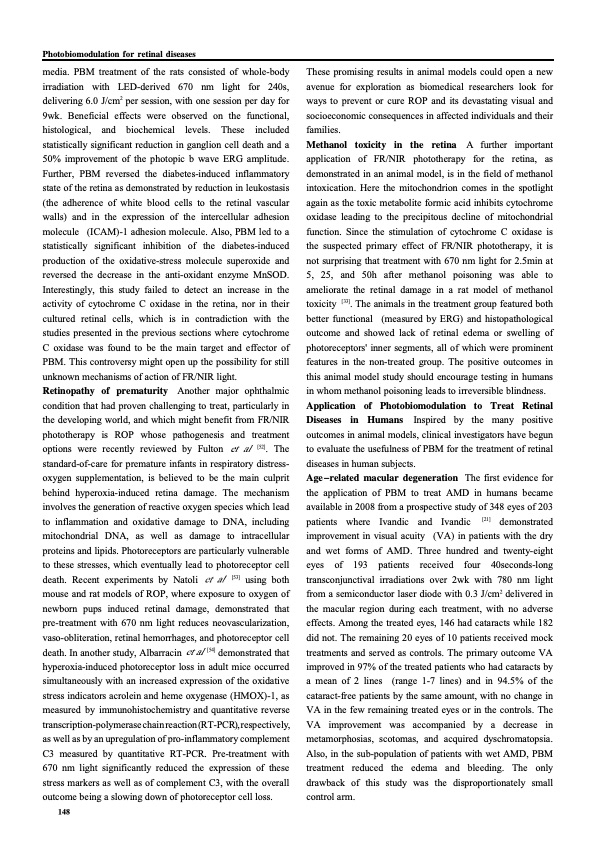
PDF Publication Title:
Text from PDF Page: 004
Photobiomodulation for retinal diseases media. PBM treatment of the rats consisted of whole-body irradiation with LED-derived 670 nm light for 240s, delivering 6.0 J/cm2 per session, with one session per day for 9wk. Beneficial effects were observed on the functional, histological, and biochemical levels. These included statistically significant reduction in ganglion cell death and a 50% improvement of the photopic b wave ERG amplitude. Further, PBM reversed the diabetes-induced inflammatory state of the retina as demonstrated by reduction in leukostasis (the adherence of white blood cells to the retinal vascular walls) and in the expression of the intercellular adhesion molecule (ICAM)-1 adhesion molecule. Also, PBM led to a statistically significant inhibition of the diabetes-induced production of the oxidative-stress molecule superoxide and reversed the decrease in the anti-oxidant enzyme MnSOD. Interestingly, this study failed to detect an increase in the activity of cytochrome C oxidase in the retina, nor in their cultured retinal cells, which is in contradiction with the studies presented in the previous sections where cytochrome C oxidase was found to be the main target and effector of PBM. This controversy might open up the possibility for still unknown mechanisms of action of FR/NIR light. Retinopathy of prematurity Another major ophthalmic condition that had proven challenging to treat, particularly in the developing world, and which might benefit from FR/NIR phototherapy is ROP whose pathogenesis and treatment options were recently reviewed by Fulton [52]. The standard-of-care for premature infants in respiratory distress- oxygen supplementation, is believed to be the main culprit behind hyperoxia-induced retina damage. The mechanism involves the generation of reactive oxygen species which lead to inflammation and oxidative damage to DNA, including mitochondrial DNA, as well as damage to intracellular proteins and lipids. Photoreceptors are particularly vulnerable to these stresses, which eventually lead to photoreceptor cell death. Recent experiments by Natoli [53] using both mouse and rat models of ROP, where exposure to oxygen of newborn pups induced retinal damage, demonstrated that pre-treatment with 670 nm light reduces neovascularization, vaso-obliteration, retinal hemorrhages, and photoreceptor cell death. In another study, Albarracin [54] demonstrated that hyperoxia-induced photoreceptor loss in adult mice occurred simultaneously with an increased expression of the oxidative stress indicators acrolein and heme oxygenase (HMOX)-1, as measured by immunohistochemistry and quantitative reverse transcription-polymerase chain reaction (RT-PCR), respectively, as well as by an upregulation of pro-inflammatory complement C3 measured by quantitative RT-PCR. Pre-treatment with 670 nm light significantly reduced the expression of these stress markers as well as of complement C3, with the overall outcome being a slowing down of photoreceptor cell loss. These promising results in animal models could open a new avenue for exploration as biomedical researchers look for ways to prevent or cure ROP and its devastating visual and socioeconomic consequences in affected individuals and their families. Methanol toxicity in the retina A further important application of FR/NIR phototherapy for the retina, as demonstrated in an animal model, is in the field of methanol intoxication. Here the mitochondrion comes in the spotlight again as the toxic metabolite formic acid inhibits cytochrome oxidase leading to the precipitous decline of mitochondrial function. Since the stimulation of cytochrome C oxidase is the suspected primary effect of FR/NIR phototherapy, it is not surprising that treatment with 670 nm light for 2.5min at 5, 25, and 50h after methanol poisoning was able to ameliorate the retinal damage in a rat model of methanol toxicity [33]. The animals in the treatment group featured both better functional (measured by ERG) and histopathological outcome and showed lack of retinal edema or swelling of photoreceptors' inner segments, all of which were prominent features in the non-treated group. The positive outcomes in this animal model study should encourage testing in humans in whom methanol poisoning leads to irreversible blindness. Application of Photobiomodulation to Treat Retinal Diseases in Humans Inspired by the many positive outcomes in animal models, clinical investigators have begun to evaluate the usefulness of PBM for the treatment of retinal diseases in human subjects. Age-related macular degeneration The first evidence for the application of PBM to treat AMD in humans became available in 2008 from a prospective study of 348 eyes of 203 patients where Ivandic and Ivandic [21] demonstrated improvement in visual acuity (VA) in patients with the dry and wet forms of AMD. Three hundred and twenty-eight eyes of 193 patients received four 40seconds-long transconjunctival irradiations over 2wk with 780 nm light from a semiconductor laser diode with 0.3 J/cm2 delivered in the macular region during each treatment, with no adverse effects. Among the treated eyes, 146 had cataracts while 182 did not. The remaining 20 eyes of 10 patients received mock treatments and served as controls. The primary outcome VA improved in 97% of the treated patients who had cataracts by a mean of 2 lines (range 1-7 lines) and in 94.5% of the cataract-free patients by the same amount, with no change in VA in the few remaining treated eyes or in the controls. The VA improvement was accompanied by a decrease in metamorphosias, scotomas, and acquired dyschromatopsia. Also, in the sub-population of patients with wet AMD, PBM treatment reduced the edema and bleeding. The only drawback of this study was the disproportionately small control arm. 148PDF Image | Photobiomodulation for the treatment of retinal diseases

PDF Search Title:
Photobiomodulation for the treatment of retinal diseasesOriginal File Name Searched:
ijo-09-01-145.pdfDIY PDF Search: Google It | Yahoo | Bing
Cruise Ship Reviews | Luxury Resort | Jet | Yacht | and Travel Tech More Info
Cruising Review Topics and Articles More Info
Software based on Filemaker for the travel industry More Info
The Burgenstock Resort: Reviews on CruisingReview website... More Info
Resort Reviews: World Class resorts... More Info
The Riffelalp Resort: Reviews on CruisingReview website... More Info
| CONTACT TEL: 608-238-6001 Email: greg@cruisingreview.com | RSS | AMP |